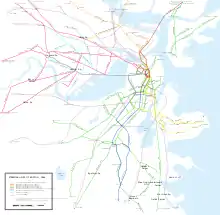Cambridge Railroad
The Cambridge Railroad (also known as the Cambridge Horse Railroad) was the first street railway in the Boston, Massachusetts area, linking Harvard Square in Cambridge to Cambridge Street and Grove Street in Boston's West End, via Massachusetts Avenue, Main Street and the West Boston Bridge.

The company was chartered and incorporated May 25, 1853, and started construction September 1, 1855. The horsecar line opened between West Cedar Street (just east of Charles Street) and Central Square on March 26, 1856.[1][2][3] Extensions opened in April to Brattle House in Brattle Square and to Revere House in Bowdoin Square.[2][3] A further extension to Mount Auburn Cemetery opened soon after, as did a branch to Porter Square.[4] The connecting Watertown Horse Railroad opened on April 27, 1857.[5] The Porter Square branch was extended to the border of West Cambridge (now Arlington); there it met the West Cambridge Horse Railroad, which opened on June 13, 1859.[4][6]
From its incorporation, the Cambridge Railroad was leased to the Union Railroad for 50 years, later passing under control of the West End Street Railway and the Boston Elevated Railway. The Red Line subway, opened March 23, 1912, now travels this route mostly underground, though the streetcar tracks remained for a while, possibly used by East Boston Tunnel (now Blue Line) trains until 1924 to travel to repair yards. The Red Line still travels over the Longfellow Bridge, successor to the West Boston Bridge, on the surface.
The line beat a rival company by buying secondhand cars from the Brooklyn City Railroad. For the first two months, no fares were charged, making the line very popular, with over 2000 passengers per day within a week. When it started to charge fares, the public was outraged, many calling for the franchises to be revoked.
See also
- Dorchester Railroad, opened spring 1857
References
- "Miscellaneous Items". New England Farmer. March 29, 1856. p. 2 – via Newspapers.com.

- George Glover Crocker (1900). From the Stage Coach to the Railroad Train and the Street Car. W.B. Clarke. p. 25 – via Google Books.
- "The Passing of the Horse Car". Street Railway Supplement of the Commercial & Financial Chronicle. William B. Dana. November 16, 1901. pp. 2–3 – via Google Books.
- "Streetcar Barns" (PDF). Cambridge Historical Commission. 2000.
- "Miscellaneous Items". New England Farmer. May 2, 1857. p. 3 – via Newspapers.com.

- Duffy, Richard A. (1997). Arlington. Arcadia. p. 17. ISBN 9780738590431 – via Google Books.
- Railroad History Database
- Scripophily.com - Cambridge Railroad Company - 1859 Massachusetts
- William D. Middleton, The Time of the Trolley, 1967, pages 15–16